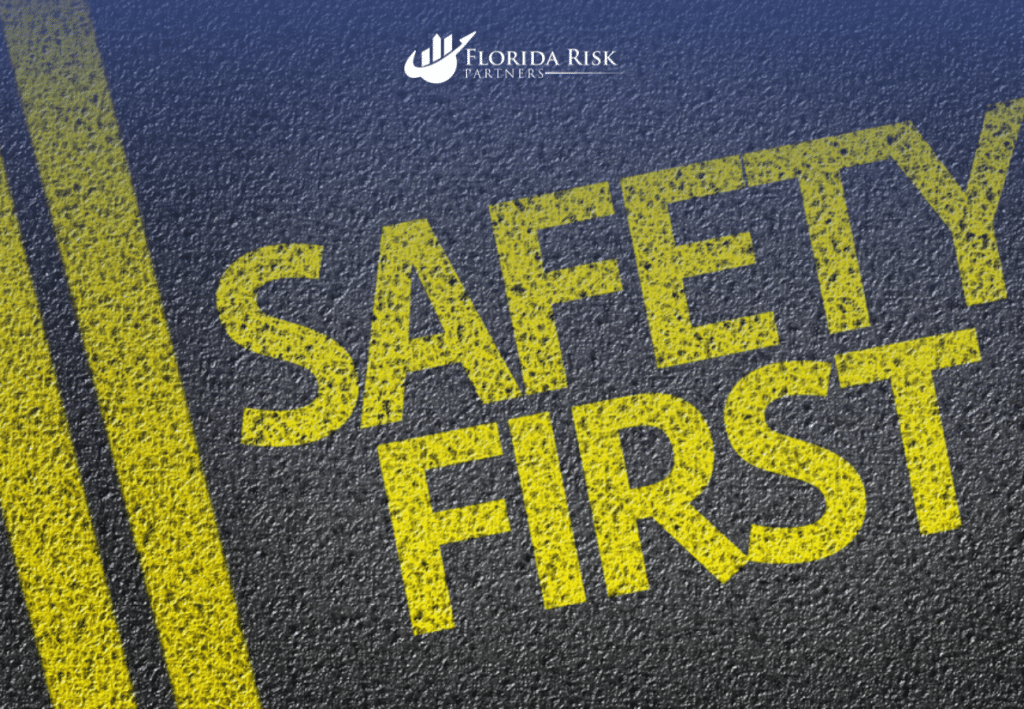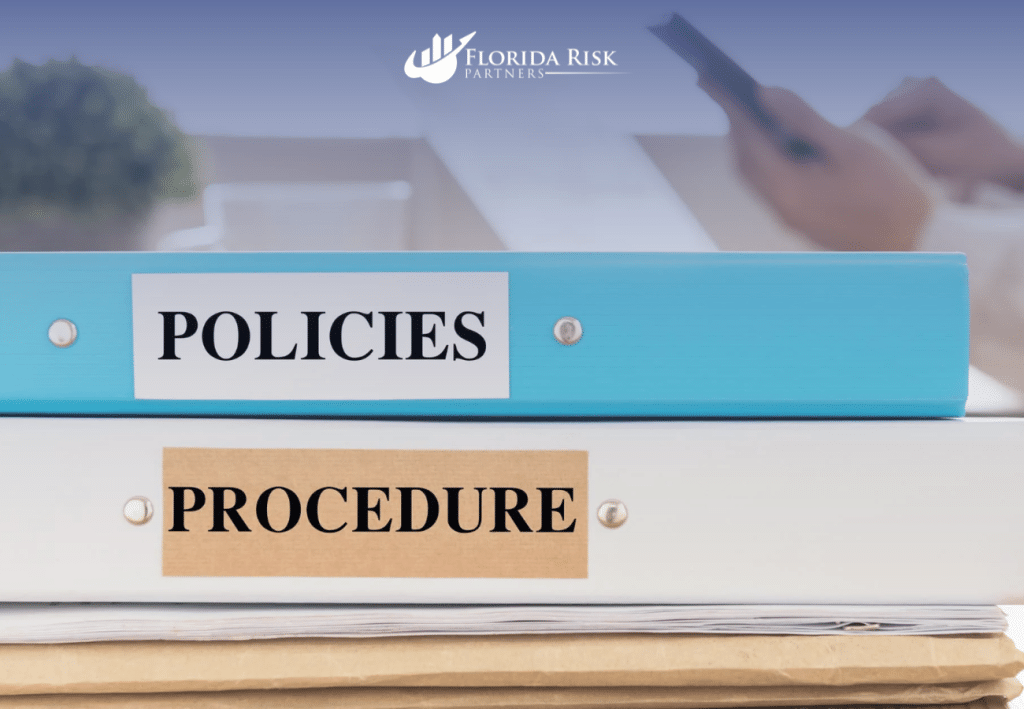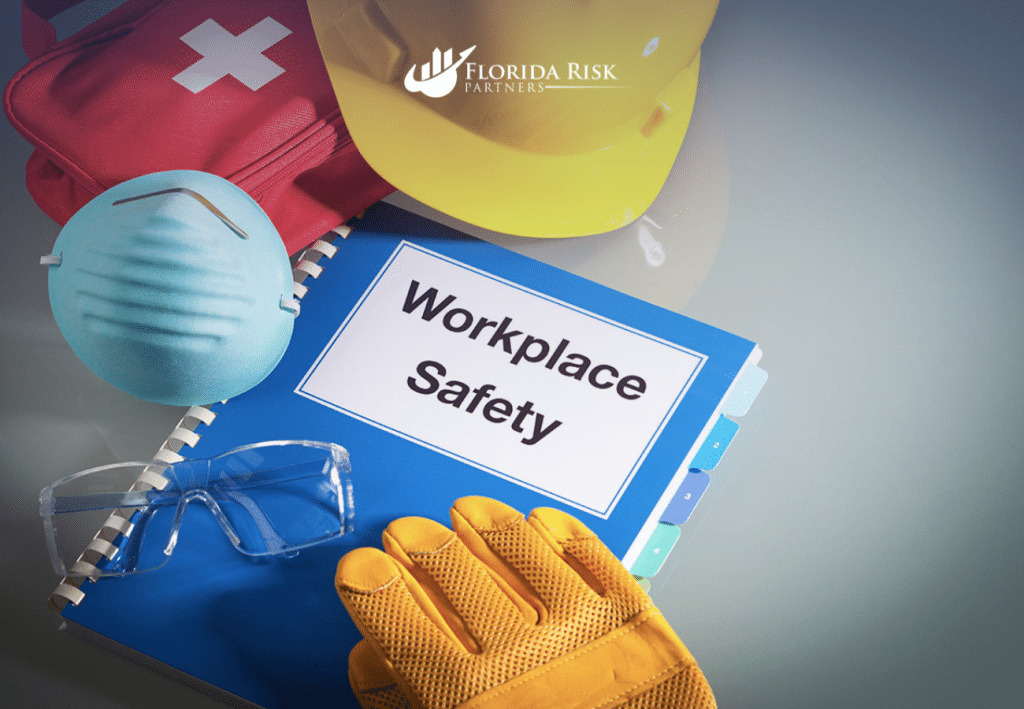-
Main Office: 1434 E. Bloomingdale Ave Valrico, FL 33596-6110
-
Phone: (888) 601-6660
-
Email: info@floridariskpartners.com

In today’s workplace, safety is more than just a legal obligation—it’s a critical component of a successful and sustainable business. One of the most effective ways to ensure a safe work environment is through the development of comprehensive safety policies and procedures. These documents serve as the foundation for a company’s safety program, guiding behavior, preventing accidents, and protecting both employees and the organization.
This blog post will explore the importance of safety policies and procedures, the key elements they should include, and the steps to develop and implement them effectively in your organization.
Why Are Safety Policies and Procedures Important?
Safety policies and procedures are essential for several reasons:
- Preventing Workplace Injuries: Well-developed safety policies and procedures help identify potential hazards and outline the steps necessary to prevent accidents. By establishing clear guidelines, companies can significantly reduce the likelihood of workplace injuries.
- Compliance with Regulations: Many industries are subject to strict safety regulations. Safety policies and procedures ensure that an organization complies with these regulations, helping to avoid costly fines and legal issues.
- Establishing a Safety Culture: Safety policies and procedures are a key part of building a safety culture within an organization. When safety is prioritized at every level, employees are more likely to engage in safe work practices and take personal responsibility for their own safety and the safety of others.
- Enhancing Employee Confidence and Productivity: A safe work environment increases employee confidence, which can lead to higher productivity. When employees feel secure, they are more focused, less stressed, and more engaged in their work.
- Protecting Organizational Resources: Accidents can lead to costly downtime, damage to equipment, and increased insurance premiums. By preventing accidents, safety policies and procedures help protect an organization’s resources and bottom line.
Key Elements of Effective Safety Policies and Procedures
A well-crafted safety policy is more than just a set of rules—it’s a comprehensive plan that addresses all aspects of workplace safety. Here are the key elements that should be included in any safety policy and procedure document:

1. Statement of Commitment
Every safety policy should begin with a statement of commitment from the organization’s leadership. This statement should clearly express the company’s dedication to maintaining a safe work environment and its commitment to the well-being of its employees. A strong commitment from leadership sets the tone for the entire organization and emphasizes the importance of safety at all levels.
2. Roles and Responsibilities
Clearly defining roles and responsibilities is critical to the success of any safety policy. This section should outline the specific responsibilities of employees, supervisors, managers, safety officers, and leadership. By clearly defining who is responsible for what, you ensure accountability and create a structure for implementing and enforcing safety practices.
3. Hazard Identification and Risk Assessment
One of the most important components of any safety policy is the process for identifying hazards and assessing risks. This section should outline the procedures for conducting regular risk assessments, identifying potential hazards, and evaluating the risks associated with them. It should also include guidelines for documenting and communicating these risks to all relevant stakeholders.
4. Safety Training and Education
Training is a key part of any safety policy. This section should describe the training requirements for all employees, including new hires, as well as ongoing training programs for existing employees. It should also outline the procedures for conducting safety drills, training sessions, and other educational activities that reinforce safe work practices.
5. Incident Reporting and Investigation
Even with the best preventive measures, incidents can still occur. This section of the safety policy should outline the procedures for reporting incidents, including near misses, injuries, and accidents. It should also detail the steps for conducting incident investigations, identifying root causes, and implementing corrective actions to prevent future occurrences.
6. Emergency Response Procedures
Emergency situations can arise at any time, and it’s essential that employees know how to respond. This section should include detailed emergency response procedures for various scenarios, such as fires, chemical spills, natural disasters, and medical emergencies. It should also outline the roles and responsibilities of employees during an emergency and provide guidelines for conducting regular emergency drills.
7. Personal Protective Equipment (PPE)
The use of Personal Protective Equipment (PPE) is often necessary to protect employees from specific hazards. This section should outline the types of PPE required for different tasks, how to properly use and maintain PPE, and the procedures for ensuring that PPE is available and used correctly.
8. Continuous Improvement and Monitoring
Safety is an ongoing process that requires regular monitoring and improvement. This section should describe the procedures for conducting regular safety audits, reviewing and updating safety policies, and ensuring that the safety program evolves with changes in the work environment and industry standards.
Steps to Develop and Implement Safety Policies and Procedures

Developing and implementing safety policies and procedures is a systematic process that requires careful planning and collaboration. Here’s a step-by-step guide to help you create effective safety policies and procedures for your organization:
1. Conduct a Thorough Risk Assessment
Before you can develop safety policies and procedures, you need to understand the specific risks and hazards present in your workplace. Conduct a comprehensive risk assessment to identify potential hazards, evaluate the risks, and prioritize the areas that need attention. This assessment will form the foundation of your safety policies and procedures.
2. Engage Key Stakeholders
Safety policies and procedures should be developed in collaboration with key stakeholders, including employees, supervisors, managers, and safety officers. Engage these stakeholders in the process to ensure that the policies and procedures are practical, effective, and aligned with the needs of the organization.
3. Draft the Policies and Procedures
Using the information gathered from the risk assessment and stakeholder input, draft the safety policies and procedures. Be sure to include all the key elements discussed earlier, and ensure that the language is clear, concise, and easy to understand. The policies should be comprehensive enough to cover all potential hazards, yet flexible enough to adapt to changes in the workplace.
4. Review and Revise
Once the draft is complete, review it with all relevant stakeholders to ensure accuracy and completeness. Make any necessary revisions based on feedback and ensure that the final document reflects the collective input of the team. This collaborative approach helps ensure buy-in and compliance from all parties involved.
5. Communicate and Train
Once the policies and procedures are finalized, communicate them to all employees. Provide training sessions to ensure that everyone understands their roles and responsibilities, as well as the specific safety practices they need to follow. Make the safety policy accessible to all employees, whether in print or digital format, and ensure that it is easily available for reference.
6. Implement the Policies and Procedures
With training completed, it’s time to implement the safety policies and procedures. Ensure that all necessary resources, such as PPE, signage, and safety equipment, are available and that employees have the tools they need to comply with the policies. Regularly monitor compliance and address any issues that arise during the implementation phase.
7. Monitor, Review, and Improve
Safety policies and procedures are not static documents—they should evolve with the organization. Regularly monitor the effectiveness of the policies through safety audits, incident reports, and employee feedback. Use this information to review and update the policies as needed to ensure continuous improvement.
Conclusion: The Importance of Strong Safety Policies and Procedures
Developing and implementing effective safety policies and procedures is essential for creating a safe and productive work environment. These documents provide the framework for identifying hazards, preventing accidents, and ensuring compliance with safety regulations. By following the steps outlined in this blog post, organizations can develop comprehensive safety policies and procedures that protect their employees and safeguard their business.
A proactive approach to safety not only helps prevent injuries but also fosters a culture of safety that benefits everyone in the organization. If your company is looking to enhance its safety practices, now is the time to start developing or refining your safety policies and procedures.
For those who need further guidance on crafting safety policies and procedures, or if you’re looking for expert assistance in conducting a risk assessment, feel free to reach out. Together, we can build a safer workplace for all.
Call Us Or
Schedule an Appointment
Select an agent below to view our online calendars and select a day and time that works best for you or call us directly at 888-601-6660. When you use our online calendars, you will receive an email with more information.



